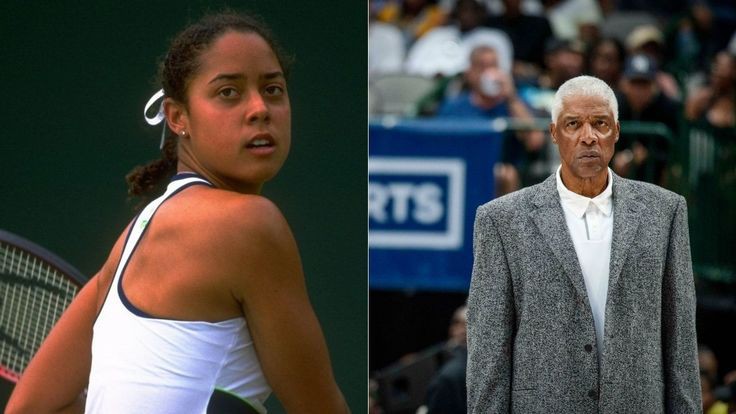
Congratulation: Julius Erving’s Daughter Alexandra Stevenson’s Historic Wimbledon Semifinal, Was Stated To be the…
Congratulation: Julius Erving’s Daughter Alexandra Stevenson’s Historic Wimbledon Semifinal, Was Stated To be the…
In a sport dominated by powerful serves and strategic gameplay, Alexandra Stevenson’s rise in professional tennis has not only been remarkable but also groundbreaking. The daughter of NBA legend Julius Erving, Stevenson carved her own path in a sport often perceived as exclusive and challenging for female athletes. Her historic journey to the Wimbledon semifinal was not just a personal achievement; it was a significant milestone for the sport and an inspiration for aspiring players around the globe.
Early Life and Background
Born on February 1, 1980, in La Jolla, California, Alexandra Stevenson was immersed in athletics from a young age. Growing up as the daughter of a professional basketball player, she was exposed to a competitive environment that nurtured her sporting ambitions. However, her journey into tennis was unique. Unlike many players who begin their training in childhood, Stevenson was introduced to the sport relatively late, picking up a racket at the age of 10.
Despite starting later than her peers, Stevenson quickly demonstrated her talent. With a natural athleticism and a fierce competitive spirit, she began to excel in junior tournaments. Her dedication to the sport was evident, as she balanced her academic responsibilities with rigorous training. By the time she reached high school, she was already a top-ranked junior player, attracting the attention of college coaches and professional scouts alike.
Turning Professional
After a successful junior career, Stevenson made the decision to turn professional in 1997. Her entry into the WTA Tour was met with both excitement and skepticism. Many questioned whether she could make a name for herself in a sport dominated by players who had trained rigorously from a young age. However, Stevenson was determined to prove her doubters wrong.
Her breakthrough came in 1999 at Wimbledon, where she entered as a wildcard. Stevenson made headlines by reaching the semifinals, becoming the first unseeded player to do so since 1975. Her powerful serve and aggressive playing style captivated audiences and experts alike. She defeated several seeded players, including the defending champion, demonstrating her ability to compete at the highest level.
The Semifinal Match
The semifinal match was a culmination of her hard work and perseverance. Facing off against a formidable opponent, Stevenson approached the match with a mix of nerves and excitement. The atmosphere at the All England Club was electric, with spectators eager to witness history in the making. Stevenson’s athleticism was on full display as she executed powerful serves and groundstrokes, pushing her opponent to the limits.
Despite falling short in the match, Stevenson’s performance was nothing short of extraordinary. She showcased not only her talent but also her resilience, fighting for every point. Her journey to the semifinal resonated with fans and fellow athletes, as it highlighted the unpredictability of sports and the potential for underdogs to rise to the occasion.
Impact on Women’s Tennis
Stevenson’s success at Wimbledon was a watershed moment for women’s tennis. It challenged the conventional narrative that only players with early training and extensive resources could succeed at the highest levels. Her story inspired many young female athletes, demonstrating that dedication, talent, and the willingness to take risks could lead to success, regardless of one’s background.
Moreover, her performance contributed to the growing visibility of women’s tennis during a time when the sport was gaining traction globally. As more female athletes began to break barriers and make headlines, Stevenson’s achievement served as a reminder of the importance of representation in sports.
Legacy and Continued Influence
In the years following her historic Wimbledon run, Stevenson continued to compete on the WTA Tour, participating in various tournaments around the world. Although she faced challenges, including injuries and stiff competition, she remained a respected figure in the sport. Her legacy extends beyond her on-court achievements; she has become a mentor and role model for aspiring athletes, particularly young women seeking to carve their paths in sports.
Stevenson’s journey illustrates the complexities of professional sports and the importance of perseverance. She often speaks about the challenges of maintaining focus and motivation in a highly competitive environment, offering valuable lessons to those who aspire to follow in her footsteps.
You may also like
Archives
Categories
- ABA
- Actor
- Actress
- Actress and singer
- Band
- Baseball
- Basketball
- Boxer
- Broadcasting corporation
- CCR
- cricketer
- Cyclists
- Dart
- Drummer
- Fictional character
- Football game
- Formula 1
- Golf
- Guitarist and songwriter
- Guitarists
- Gymnastics
- Hockey
- Ice hockey
- Marathon
- MLB
- Motocross
- MotoGP
- Motorcross
- Musician
- Musician and drummer
- NFL
- NHL
- NRL
- Racer
- Red bull Racing
- Rider
- Rock band
- Rugby league
- Simone Biles
- Singer and songwriter
- Songwriter and musician
- Sport commentator
- Tennis
- Texas longhorns
- Track and field athlete
- Uncategorized
Leave a Reply